
Thank you for visiting HOJO website. If you have any enquiry, please feel free to get in touch with us at
▼ Akira Hojo
▼ Hojo Newsletter
▼ HOJO FACEBOOK





HOME>Dark tea>Meng Hai Ripe Pu-erh
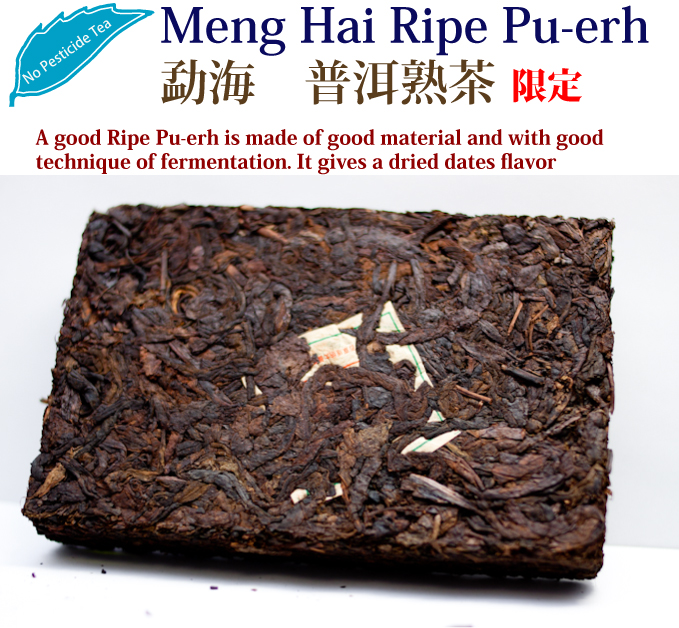
Ripe Pu-erh tea is made by fermentation of mold. A good manaement of fermentation is essential to get an ideal flavor of ripe Pu-erh tea. In fact, a number of customers told us that they did not enjoy Pu-erh tea at all due to its unpleasant flavor. Most of them tend to associate Pu-erh flavor as moldy, earthy, vintage (smells like old furniture); some even commented that Pu-erh smells like stinky feet. In fact, these typical flavors of Pu-erh tea indicate that the fermentation was not properly carried out. The Pu-erh tea that was well-made during fermentation gives a pleasant scent like sun-dried Chinese dates. The flavor is sweet and mildly fruity. It gives a mellow mouth-feel and its delicate fruity flavor sublimes in the mouth.
The difference between Raw pu-erh and Ripe Pu-erh is explained in the following page or following diagram
The moldy and earthy flavor is produced by the contamination of incorrect type of mold. During fermentation, once the temperature, humidity or moisture content of tea leaves is out of control, the incorrect type of mold would grow and thrive. Usually, odor that is similar to smelly feet or dried squid is produced because of the contamination of bacteria. Pu-erh that gives unpleasant odor is not only “horrible” to drink, but also risky for our health. Those unintentionally grown molds and bacteria sometimes produce toxin. It is very important to remember which flavor is correct and only look for the Pu-erh with the right quality.
Meng Hai Ripe Pu-erh is produced in a place with a long history of making Pu-erh teas in South Yunnan. Tea is made into 250g brick and rectangle in shape. This tea can be kept for more than 10 years, as long as it is kept in a dry atmosphere.
For this Pu-erh, you can enjoy as much as 2 to 3 liters of tea with 5g of tea leaf.
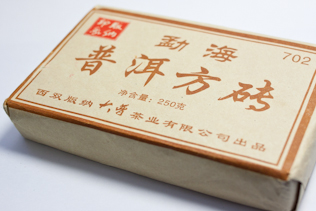 |
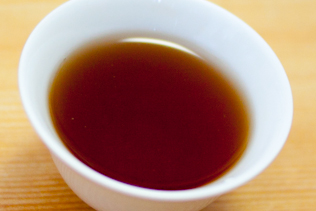 |
|
| Meng Hai Ripe Pu-erh comes in 250g brick | ea is very thick until it forms a golden ring along the edge of cup. |
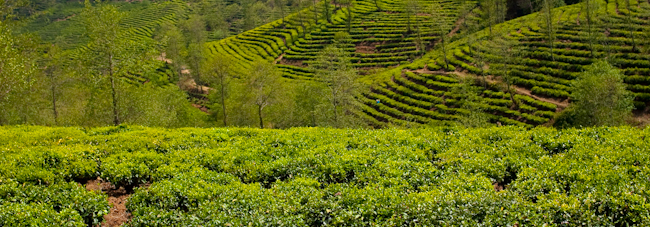
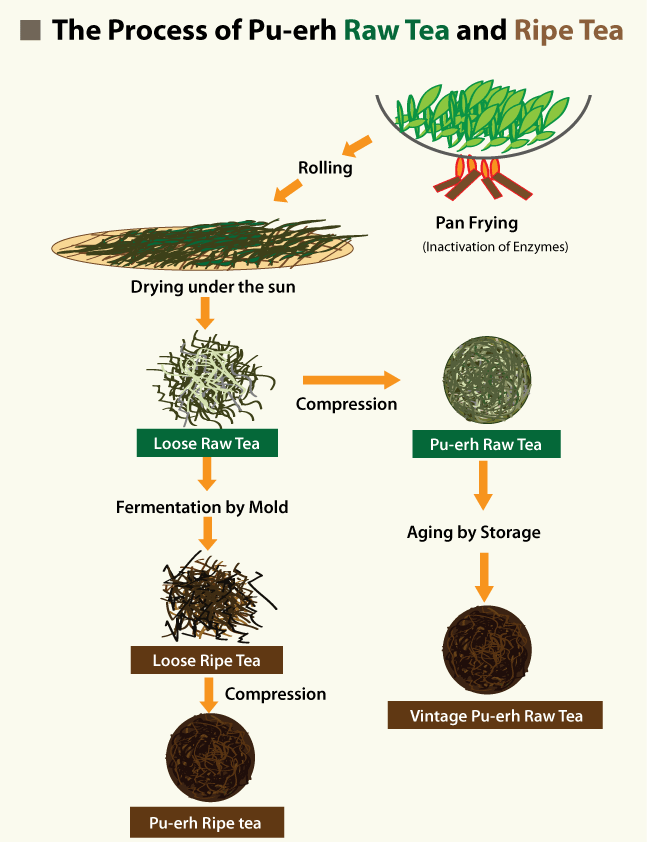
In you are using tap water, it is necessary to filter the water using an activated carbon filter. If not, you wouldn’t be able to enjoy the authentic taste of tea. Chlorine is added to tap water in order to sanitize bacteria. This chlorinated water will also harm our body cells. Concerning about our health condition, it is very important to remove chlorine from drinking water. The most effective method in removing chlorine is to install an activated carbon filter. This type of filter is designed for removing organic substance. It will remove not only chlorine, but also other harmful substance such as contaminated pesticide. The activated carbon filter can be easily obtained from the common hardware shop in most countries. If activated carbon filter is not available, please place a charcoal inside the water and leave it for over night. The material composed of activated carbon filter is made of ground charcoal. The difference is that activated carbon filter contains much finer particles and hence it has extremely large surface area for a better efficiency in filtration. We do not suggest RO water (reversed osmosis water) or distilled water. This water carries no mineral, the taste and flavor of tea tends to be very unstable, unless you have very superior quality tea and tea equipment.
In the long run, you may observe a thick layer of scale accumulated inside your kettle. Our mother usually taught us to wash and remove it with citric acid. But please do not even try to remove the scale. Scale consists of minerals that exist in the water. The mineral composition is reflected from the water you used. If you remove the scale, the mineral ion balance between scale and water is destroyed. This balance is called buffer effect in science. The flavor and taste will seriously run out and you won’t be able to get previous taste and flavor for a long time. It is also important to stick to the same type of water whenever brewing tea. If source of water is changed, it carries different type of minerals. It will affect the mineral ion balance too.
Go to further information about suitable water for brewing tea >>
To determine the quantity of tea leaves to be used, we divide the volume of water by 40. For example: the volume of teapot = 200ml; 200ml/40 =5g. You need to measure 4g of tea leaves for 200ml of water.
Rinse tea pot with boiling water for 10 seconds in order to warm it up. After 10 seconds, remove hot water from the warmed tea pot.
Pour boiling water onto tea leaf up to more than 70% of the volume of tea pot. It is not for washing purpose, but to warm up the tea leaf so that leaf will unfurl to release its flavor and taste. Once again pour off hot water within 7 to 10 seconds.
Brewing Time
1st: 60 seconds
2nd brewing onwards: Less than a few second. You just need to run though hot water with tea.
Note: Please remove the lid while you are waiting for subsequent brewing. Tea leaf will be over steamed and get oxidized if the lid is not removed.
Once a bag of tea is opened, Tea should be kept in ambient and dry conditions such as in the living room, but it must be completely away from humidity. Tea should not be kept in the kitchen as the environment is very humid. Avoid enclosed area such as inside the cupboard or drawer as these places are damp. Also avoid opening the bag of tea in humid atmosphere. It is recommended to open the bag during a sunny day or under air-conditioned atmosphere. Once tea leaves absorb moisture, deterioration of tea will be triggered within a few days. Tea will then give an astringent taste, sometime it tastes sour. The fresh aroma also becomes weaker.
Traditionally, Pu-erh tea is compressed to remove oxygen from the leaves and kept it intact. It was the wisdom of ancient people to keep tea without oxygen and let it matured very well.
From scientific point of view, oxidation does not only refer to receiving oxygen. The oxidation also takes place when it releases hydrogen and receives electron. Even if tea is kept without oxygen, it will still undergo oxidation.
In 1960's, generally Pu-erh tea was compressed tightly and shaped like a bing (flat and thin round cake). It was called “iron bing”. The tea leaf was compressed extremely tight until it became like a piece of stone; we can hardly pry it even if we use the proper tool that designed for prying the Pu-erh cake. This style of compression succeeded the elimination of oxygen from the tea leaves. If you have ever tried this kind of Pu-erh iron bing, you would know that it was very well-matured. It gives flavour like honey with fruity note and gives no earthy flavour at all. The only problem is that it is so difficult to loosen the leaves from the iron bing and the leaves are often damaged during the process.
On the other hand, nowadays most of Pu-erh cakes are loosely compressed. Some of the Pu-erh cakes can be easily break apart by fingers. Obviously there is oxygen remained in between the leaves. If we keep loosely-compressed Pu-erh in ambient environment, tea will expose to not only oxygen but also moisture and develop unwanted oxidation that usually generates earthy flavour. To achieve the same maturation effect like the iron bing, we encourage customer to keep Pu-erh tea without oxygen. With modern technology, we are able to apply the same theory. Some people in Taiwan intentionally keep high mountain oolong in the vacuum bag for a few years. In the beginning, high mountain oolong is green in colour and it gives a delightful fresh flowery flavour. After a few years of maturation, the leaves turn into yellow colour and it gives the flavour like ripen peach or apricot. This is exactly the same effect as what we are looking for in Pu-erh tea. Based on our experience, well-matured Pu-erh tea gives a very fruity flavour and no earthy or mouldy flavour at all.

Please feel free to send us e-mail for enquiry at:

 |
We accept various kinds of credit card through Paypal.
Only if customer prefer other option of payment, we suggest "Bank Transfer".
Various choice of shipping method
EMS, SAL, Small Packet, Small Packet (SAL) Yamato Express and Surface
For shipping tea, we usually suggest small air parcel, the estimated shipping cost of tea in 100g (with wrapping material ) is
Small Parcel
USA JPY 600, EU JPY600 and Asia JPY470
Small Packet (SAL)
USA JPY380, EU JPY380 and Asia JPY320
The shipping fee to oversea by small air parcel happens to be even cheaper than domestic shipping fee in Japan.
For your information, some countries, EU in particular imposes custom duty. We need buyer to bare the duty. We are sorry, but we cannot change the amount on the invoice, and we do not mark any packages as gifts. We will strictly follow the custom regulation.
A GIFT FROM THE MOUNTAIN
since 2006
Copyright (C) 2006-2007 HOJO co.,ltd. All Rights Reserved.